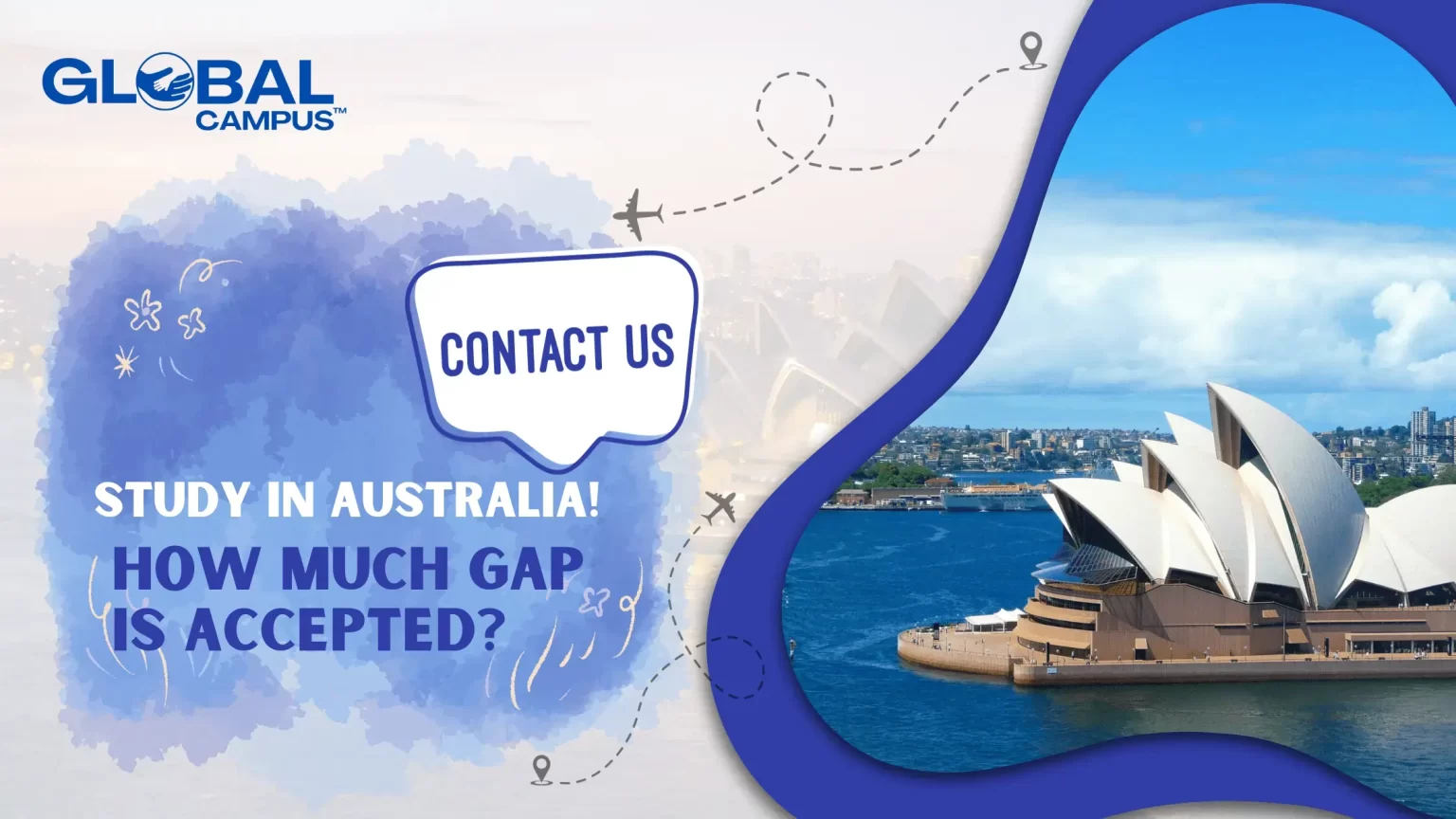How Much Gap Is Accepted to Study in Australia?
Introduction:
Australia is one of the world’s top education destinations, with thousands of applications to its world-class universities each year. In terms of the number of international students hosted in an academic year, Australia ranks third. Aside from high educational standards, the country promises excellent job possibilities and a comfortable standard of living. Australia is a popular study abroad location for international students for these reasons.
Securing a place at a reputable university in Australia necessitates earnest devotion. It should be noted that taking a gap year after finishing high school or an undergraduate programme has become a widespread pattern in recent years. Personal or financial concerns, work experience, tenure, or the time required to prepare for the course students choose to study are all possible factors. However, you must consider how big of a gap is appropriate for studies in Australia. A one-year break is regarded as standard, but other voluntary and involuntary causes may lead to a student desiring a longer gap period.
Although each institution in Australia has its own admissions rules, most of them permit one- or two-year gaps. However, if the gap widens by three or four years, you must present valid justifications.
Other considerations that influence gap acceptability include whether you are applying for an undergraduate or postgraduate course; however, justification is required in all circumstances, with evidence in some cases.
Share this Blog

Need guidance? Let us help you.
Introduction:
Australia is one of the world’s top education destinations, with thousands of applications to its world-class universities each year. In terms of the number of international students hosted in an academic year, Australia ranks third. Aside from high educational standards, the country promises excellent job possibilities and a comfortable standard of living. Australia is a popular study abroad location for international students for these reasons.
Securing a place at a reputable university in Australia necessitates earnest devotion. It should be noted that taking a gap year after finishing high school or an undergraduate programme has become a widespread pattern in recent years. Personal or financial concerns, work experience, tenure, or the time required to prepare for the course students choose to study are all possible factors. However, you must consider how big of a gap is appropriate for studies in Australia. A one-year break is regarded as standard, but other voluntary and involuntary causes may lead to a student desiring a longer gap period.
Although each institution in Australia has its own admissions rules, most of them permit one- or two-year gaps. However, if the gap widens by three or four years, you must present valid justifications.
Other considerations that influence gap acceptability include whether you are applying for an undergraduate or postgraduate course; however, justification is required in all circumstances, with evidence in some cases.
Table of Contents
How Many Years of Gap is Accepted under an Australian Student Visa?
The majority of Australian universities have distinct admissions standards for students. While the acceptance quotient for a gap year varies between Australian universities, there are some common principles to follow. In general, most universities will allow 1-2 year study gaps.
Larger gaps of 3-4 years will, however, necessitate justification on your part. Other criteria of acceptability are determined by the course type, i.e. whether you want to pursue a postgraduate or undergraduate degree. Simultaneously, you will have to demonstrate why you took the gap year. Those taking a gap year to work may be required to show the pay slips and work documents. Those who take a gap year for medical reasons will be required to provide documentation. As a matter of thumb, 1-2 gap years are permitted.
The Influence of Gap Years on Students Planning to Study in Australia
Universities in Australia let students include gap years on their resumes, provided that the student can demonstrate that they have valid reasons for doing so and that they have credible documents to back up their claims. However, you should keep in mind that a delay of more than one year may have a detrimental impact on your chances of being accepted into higher-ranked universities. To guarantee that you have legitimate records to support reasons such as health challenges, personal troubles, or other reasons that are comparable, you need to make sure that you have them.
It is recommended that you engage in some productive activity that is related to your field of specialisation in order to demonstrate to the institution that you have engaged in activity in order to prevent any consequences that may arise as a result of gap years on your application portfolio. Not only does this contribute to the formation of a favourable professional image, but it also demonstrates your sincerity and seriousness.
The submission of false or erroneous documents to university admissions offices in Australia is taken extremely seriously, and any action taken on your behalf might result in a permanent ban on immigration to the country. When you are putting together the documents that will validate your reasons for taking a break in your education, it is understood that honesty is the best policy to follow.
What are acceptable Study Gap reasons?
Some of the most common and widely recognised causes for study gaps in Australia include the following, notwithstanding the fact that every educational institution and nation may have its own regulations and criteria for allowing study gaps:
- Financial issues: If a student is experiencing financial issues or hurdles that prevent them from continuing their education, this might be considered a good excuse for taking a brief vacation before continuing their studies.
- Job Opportunity: In order to take advantage of professional possibilities or to gain actual job experience in their chosen field of interest, some students may have made the decision to temporarily withdraw from their academic endeavours in order to pursue alternative career paths.
- Undertaking Travel: Taking a gap year on purpose in order to travel the globe, gain life experiences, or participate in volunteer work might be seen favourably by some educational institutions. This is because it can greatly contribute to the development and progress of the individual concerned.
- Military Training: One’s educational pursuits may be put on hold if they are required to serve in the military or perform mandatory national service requirements in some nations, such as the United States of America. The majority of people agree that this is a valid explanation.
- Family Responsibility: Responsibilities relating to family concerns, such as providing care for a family member who is unwell, taking on parenting responsibilities, or completing large family commitments, are usually regarded as sufficient grounds for interrupting one’s academic journey for a short period of time.
- Health Issues: The presence of health-related circumstances might be considered a valid justification for an academic gap. These circumstances include health problems or medical disorders that prevented a student from continuing their educational endeavours during a certain time period. It is possible that pertinent medical documents are required in order to provide evidence for this.
Steps to obtain a student visa for Australia
International students have a very simple approach to getting a student visa through the Overseas Programme, which is provided by the government of Australia. In order to obtain your student visa for the purpose of studying in Australia, you may follow these several steps:
- Step 1: In order to begin the process of obtaining a visa, the first step is to submit an application to a university in Australia and get a confirmation of enrollment, often known as a CoE.
- Step 2: Create a profile on IMMI account – Department of Home Affairs, Australia.
- Step 3: Make sure you have digital copies of all the required documents for the visa application.
- Step 4: Fill out your visa application online. The official website for visa applications is both user-friendly and instructive at the same time.
- Step 5: Obtain a Transaction Reference Number, also known as a TRN. If you want to obtain this number, you will need to pay a fee for the visa once you have finished the application process.
- Step 6: It is in your best interest to schedule your medical examination in advance because the granting of your visa is contingent upon the results of your examination. You also need to make sure that you are able to schedule an interview with the officials. According to the applicant’s citizenship, this step may or may not be applicable to them.
- Step 7: Receive your visa decision. You will need to allow time for the decision to be announced.
Final Thoughts
It is a wonderful option to study higher education in Australia and then look for employment prospects when you have completed your studies. The fact that English is used as the medium of instruction for the courses, combined with the fact that an Australian degree is highly recognised all over the world, makes it an attractive destination for students from India. A competitive advantage may be gained by planning your application well in advance, which also allows you to circumvent obstacles such as gap years. In addition, India and Australia have inked a contract that will mutually acknowledge their respective qualifications.
If you are looking to study in Australia, our team of experts can help you get started in the right direction. We provide an exceptional bouquet of services to study abroad aspirants. You may contact us for further information and assistance.
FAQs
Do Australians Universities accept study gaps?
Even though most institutions have their own admissions standards, a study gap is permissible in Australia. The rules for gap years will differ throughout the country’s institutions. In these cases, smaller periods of 1-2 years are considered typical. However, you will need to offer enough reason for longer gaps of 3-4 years on average. Another consideration is the course you desire to enrol in. Postgraduate courses may be more accepting of gap years because you may have used this time for employment or competitive tests. Undergraduate gap years may be restricted to 1-2 years. Anything more may be difficult to justify. Always back up your statements with genuine documents and other proof. This will expedite approval from both your university and the visa authorities.
What exactly is an education gap?
A gap year in education will occur between higher education and Class XII. It might also be the time between finishing your undergraduate degree and continuing further education. The amount of time spent without job after graduation will be considered the gap year. The gap year is defined as any period of time when you are not engaged in academic or professional productive activities. The word refers to students who take a year or two off from traditional education, typically between high school and college/university. This is the standard definition that is used worldwide.
How to cover your study gap for Australia?
Your study gap might be addressed for education in Australia. You need a gap year and supporting paperwork to prove your claims. This helps your school approve you quickly. You can show gap year job and employment via experience/internship letters, pay slips, and offer letters. Health or medical certifications might also prove you took a gap year for medical treatment. You can also submit documents pertaining to competitive tests that you took during the gap year(s). Applying to an Australian university requires substantiating the reasons and covering the study gap.
Is it simple to acquire an Australian student visa?
Acquiring an Australian student visa might be simple provided you carefully follow the processes. Ensure you have a verified offer from an Australian university, acquire all required papers, and correctly complete the visa application. While health exams and financial restrictions may be required, a well-prepared application boosts your chances of success.

